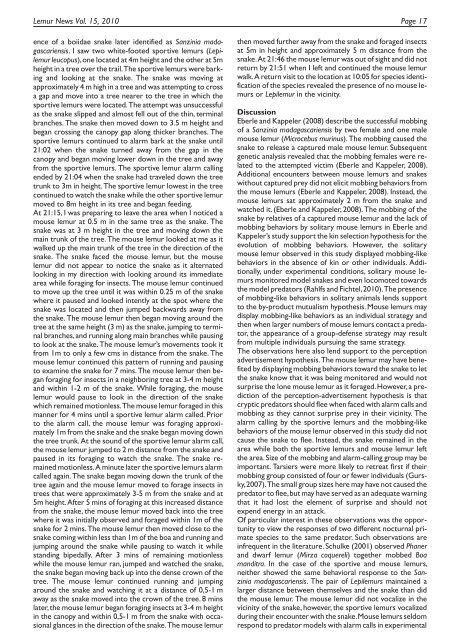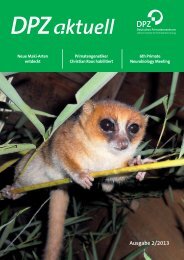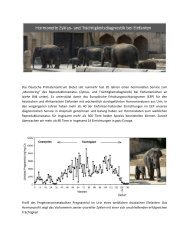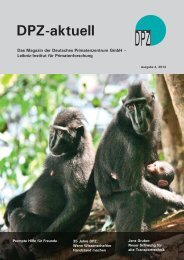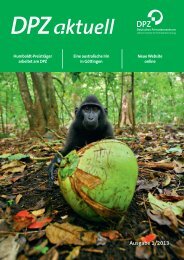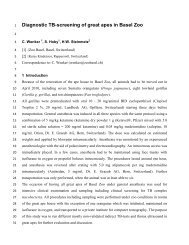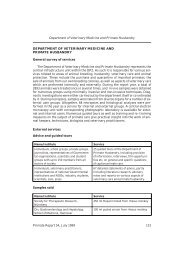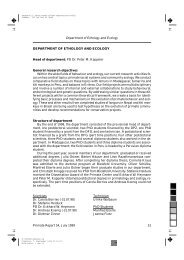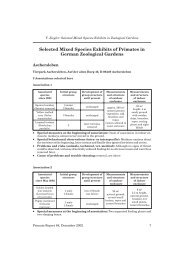Vol. 15 - Deutsches Primatenzentrum
Vol. 15 - Deutsches Primatenzentrum
Vol. 15 - Deutsches Primatenzentrum
You also want an ePaper? Increase the reach of your titles
YUMPU automatically turns print PDFs into web optimized ePapers that Google loves.
Lemur News <strong>Vol</strong>. <strong>15</strong>, 2010 Page 17<br />
ence of a boiidae snake later identified as Sanzinia madagascariensis.<br />
I saw two white-footed sportive lemurs (Lepilemur<br />
leucopus),one located at 4m height and the other at 5m<br />
height in a tree over the trail.The sportive lemurs were barking<br />
and looking at the snake. The snake was moving at<br />
approximately 4 m high in a tree and was attempting to cross<br />
a gap and move into a tree nearer to the tree in which the<br />
sportive lemurs were located.The attempt was unsuccessful<br />
as the snake slipped and almost fell out of the thin, terminal<br />
branches. The snake then moved down to 3.5 m height and<br />
began crossing the canopy gap along thicker branches. The<br />
sportive lemurs continued to alarm bark at the snake until<br />
21:02 when the snake turned away from the gap in the<br />
canopy and began moving lower down in the tree and away<br />
from the sportive lemurs. The sportive lemur alarm calling<br />
ended by 21:04 when the snake had traveled down the tree<br />
trunk to 3m in height. The sportive lemur lowest in the tree<br />
continued to watch the snake while the other sportive lemur<br />
moved to 8m height in its tree and began feeding.<br />
At 21:<strong>15</strong>, I was preparing to leave the area when I noticed a<br />
mouse lemur at 0.5 m in the same tree as the snake. The<br />
snake was at 3 m height in the tree and moving down the<br />
main trunk of the tree. The mouse lemur looked at me as it<br />
walked up the main trunk of the tree in the direction of the<br />
snake. The snake faced the mouse lemur, but the mouse<br />
lemur did not appear to notice the snake as it alternated<br />
looking in my direction with looking around its immediate<br />
area while foraging for insects. The mouse lemur continued<br />
to move up the tree until it was within 0.25 m of the snake<br />
where it paused and looked intently at the spot where the<br />
snake was located and then jumped backwards away from<br />
the snake. The mouse lemur then began moving around the<br />
tree at the same height (3 m) as the snake,jumping to terminal<br />
branches,and running along main branches while pausing<br />
to look at the snake. The mouse lemur’s movements took it<br />
from 1m to only a few cms in distance from the snake. The<br />
mouse lemur continued this pattern of running and pausing<br />
to examine the snake for 7 mins. The mouse lemur then began<br />
foraging for insects in a neighboring tree at 3-4 m height<br />
and within 1-2 m of the snake. While foraging, the mouse<br />
lemur would pause to look in the direction of the snake<br />
which remained motionless.The mouse lemur foraged in this<br />
manner for 4 mins until a sportive lemur alarm called. Prior<br />
to the alarm call, the mouse lemur was foraging approximately<br />
1m from the snake and the snake began moving down<br />
the tree trunk.At the sound of the sportive lemur alarm call,<br />
the mouse lemur jumped to 2 m distance from the snake and<br />
paused in its foraging to watch the snake. The snake remained<br />
motionless.A minute later the sportive lemurs alarm<br />
called again. The snake began moving down the trunk of the<br />
tree again and the mouse lemur moved to forage insects in<br />
trees that were approximately 3-5 m from the snake and at<br />
5m height.After 5 mins of foraging at this increased distance<br />
from the snake, the mouse lemur moved back into the tree<br />
where it was initially observed and foraged within 1m of the<br />
snake for 2 mins. The mouse lemur then moved close to the<br />
snake coming within less than 1m of the boa and running and<br />
jumping around the snake while pausing to watch it while<br />
standing bipedally. After 3 mins of remaining motionless<br />
while the mouse lemur ran, jumped and watched the snake,<br />
the snake began moving back up into the dense crown of the<br />
tree. The mouse lemur continued running and jumping<br />
around the snake and watching it at a distance of 0,5-1 m<br />
away as the snake moved into the crown of the tree. 8 mins<br />
later,the mouse lemur began foraging insects at 3-4 m height<br />
in the canopy and within 0,5-1 m from the snake with occasional<br />
glances in the direction of the snake.The mouse lemur<br />
then moved further away from the snake and foraged insects<br />
at 5m in height and approximately 5 m distance from the<br />
snake.At 21:46 the mouse lemur was out of sight and did not<br />
return by 21:51 when I left and continued the mouse lemur<br />
walk.A return visit to the location at 10:05 for species identification<br />
of the species revealed the presence of no mouse lemurs<br />
or Lepilemur in the vicinity.<br />
Discussion<br />
Eberle and Kappeler (2008) describe the successful mobbing<br />
of a Sanzinia madagascariensis by two female and one male<br />
mouse lemur (Microcebus murinus). The mobbing caused the<br />
snake to release a captured male mouse lemur. Subsequent<br />
genetic analysis revealed that the mobbing females were related<br />
to the attempted victim (Eberle and Kappeler, 2008).<br />
Additional encounters between mouse lemurs and snakes<br />
without captured prey did not elicit mobbing behaviors from<br />
the mouse lemurs (Eberle and Kappeler, 2008). Instead, the<br />
mouse lemurs sat approximately 2 m from the snake and<br />
watched it. (Eberle and Kappeler, 2008). The mobbing of the<br />
snake by relatives of a captured mouse lemur and the lack of<br />
mobbing behaviors by solitary mouse lemurs in Eberle and<br />
Kappeler’s study support the kin selection hypothesis for the<br />
evolution of mobbing behaviors. However, the solitary<br />
mouse lemur observed in this study displayed mobbing-like<br />
behaviors in the absence of kin or other individuals. Additionally,<br />
under experimental conditions, solitary mouse lemurs<br />
monitored model snakes and even locomoted towards<br />
the model predators (Rahlfs and Fichtel,2010).The presence<br />
of mobbing-like behaviors in solitary animals lends support<br />
to the by-product mutualism hypothesis. Mouse lemurs may<br />
display mobbing-like behaviors as an individual strategy and<br />
then when larger numbers of mouse lemurs contact a predator,<br />
the appearance of a group-defense strategy may result<br />
from multiple individuals pursuing the same strategy.<br />
The observations here also lend support to the perception<br />
advertisement hypothesis.The mouse lemur may have benefited<br />
by displaying mobbing behaviors toward the snake to let<br />
the snake know that it was being monitored and would not<br />
surprise the lone mouse lemur as it foraged.However,a prediction<br />
of the perception-advertisement hypothesis is that<br />
cryptic predators should flee when faced with alarm calls and<br />
mobbing as they cannot surprise prey in their vicinity. The<br />
alarm calling by the sportive lemurs and the mobbing-like<br />
behaviors of the mouse lemur observed in this study did not<br />
cause the snake to flee. Instead, the snake remained in the<br />
area while both the sportive lemurs and mouse lemur left<br />
the area.Size of the mobbing and alarm-calling group may be<br />
important. Tarsiers were more likely to retreat first if their<br />
mobbing group consisted of four or fewer individuals (Gursky,2007).The<br />
small group sizes here may have not caused the<br />
predator to flee,but may have served as an adequate warning<br />
that it had lost the element of surprise and should not<br />
expend energy in an attack.<br />
Of particular interest in these observations was the opportunity<br />
to view the responses of two different nocturnal primate<br />
species to the same predator. Such observations are<br />
infrequent in the literature. Schulke (2001) observed Phaner<br />
and dwarf lemur (Mirza coquereli) together mobbed Boa<br />
manditra. In the case of the sportive and mouse lemurs,<br />
neither showed the same behavioral response to the Sanzinia<br />
madagascariensis. The pair of Lepilemurs maintained a<br />
larger distance between themselves and the snake than did<br />
the mouse lemur. The mouse lemur did not vocalize in the<br />
vicinity of the snake, however, the sportive lemurs vocalized<br />
during their encounter with the snake.Mouse lemurs seldom<br />
respond to predator models with alarm calls in experimental


